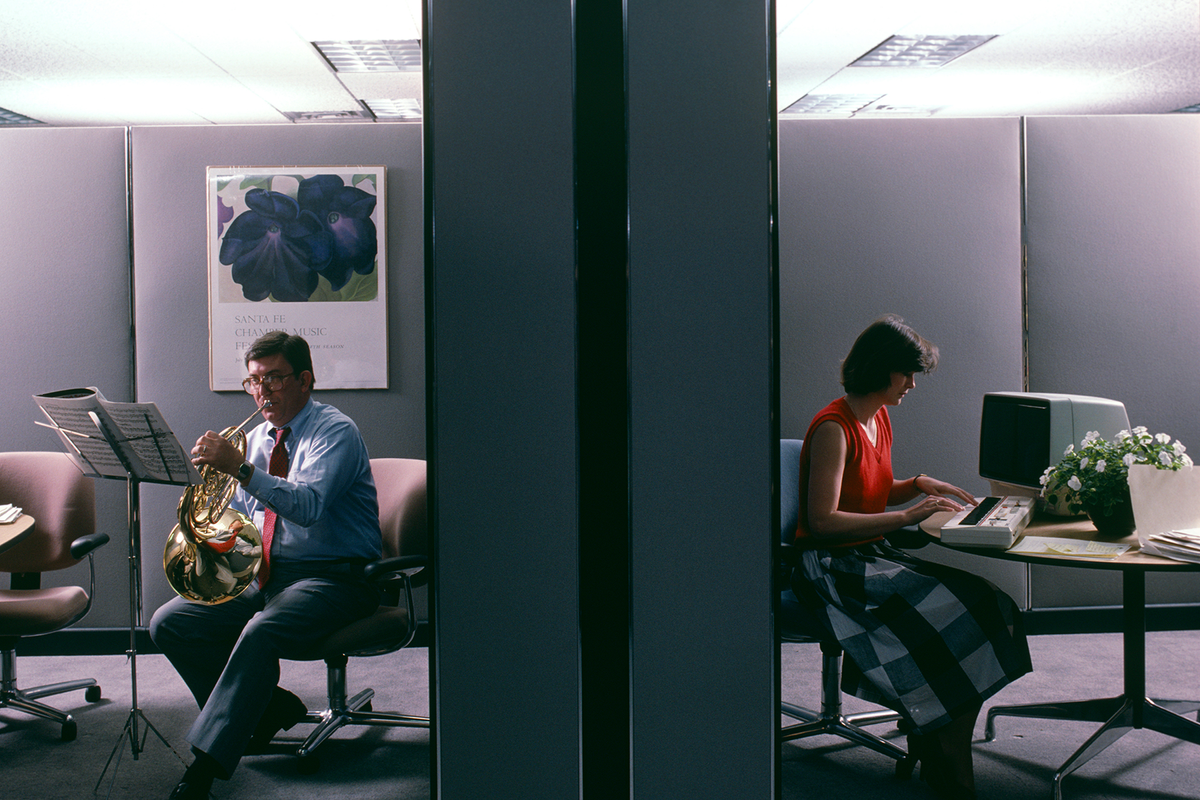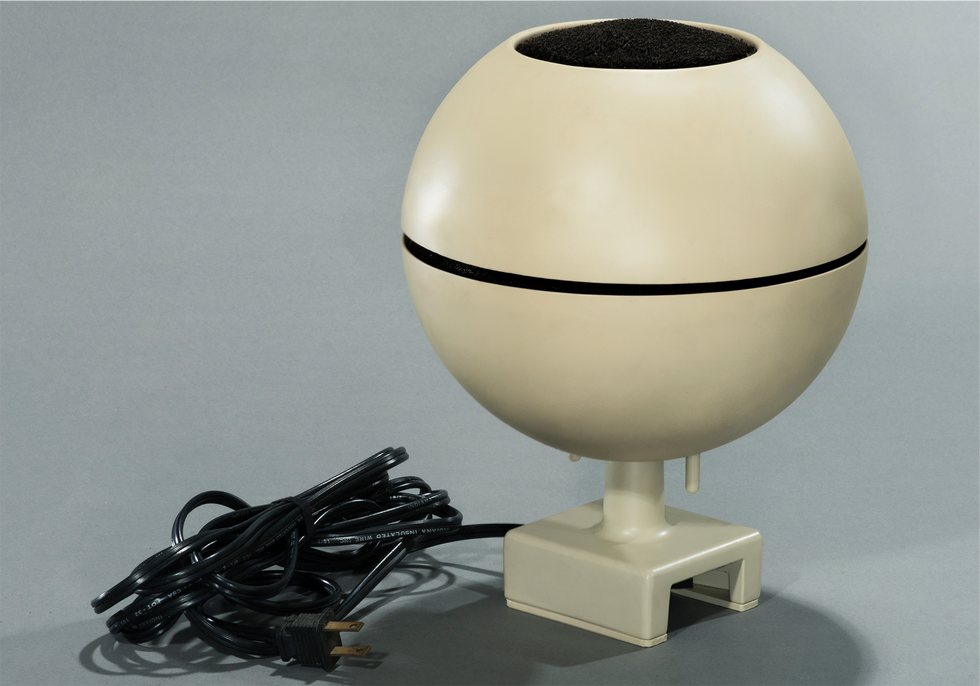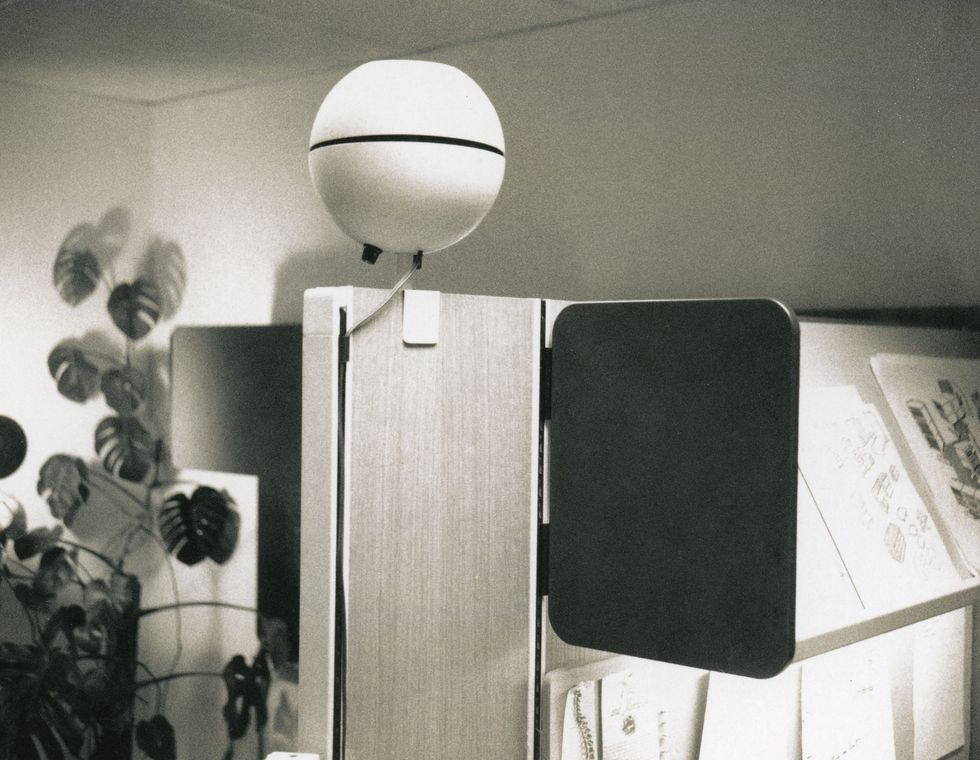A Brief History of the Office Cubicle

In 1964, the office cubicle was born. For that you can thank Robert Propst, a designer at the Herman Miller furniture company. Four years earlier, he had proposed a radical alternative to the office bullpen: the Action Office. He envisioned it as a holistic and integrated system designed to increase worker efficiency while providing an ergonomic workspace.
Sadly, the Action Office soon devolved into soulless cubicle farms, pilloried in Dilbert cartoons and despised by office workers everywhere. Chief among the complaints: noisy coworkers and a lack of privacy.
To address both issues, Propst and Jack Kelley created the Acoustic Area Conditioner in 1975. The AAC was a noise-canceling device designed to hush unwanted background chatter. The globe became known around the company as the maskitball. It was basketball season," Kelley explained to Kristen Gallerneaux, a curator at The Henry Ford (where the AAC pictured below resides). The moniker stuck.
 Henry Miller's Acoustic Area Conditioner was a white-noise machine for corporate workspaces.The Henry Ford
Henry Miller's Acoustic Area Conditioner was a white-noise machine for corporate workspaces.The Henry Ford
The 19-centimeter-diameter globe was indeed just a little smaller than a basketball. It perched atop a cubicle wall approximately 2 meters from the floor. High frequencies were emitted from the top of the globe and mid- and low-level frequencies from the equator. Office workers could tune the device within preset limits. In larger open offices, AACs could be spaced every 3 to 3.5 meters to create a white-noise zone.
The theory and reality of Herman Miller's Action OfficeThe AAC was part of a larger effort at Herman Miller to optimize office acoustics. Propst and Michael Wodka wrote The Action Office Acoustic Handbook: A Guide for the Open Plan Facility Manager, Planner and Designer (Herman Miller Research Corp., 1975) as a manual for designing open-office workspaces.
This video shows the Action Office and its successor, the Action Office 2:
The History of Herman Miller Action Office II (AO2)www.youtube.com
The book lays out quantitative guides for best practices, such as not having to speak louder than 60 decibels over a distance of 1.8 meters for normal conversation. The background hum of a typical office they put at 40 to 50 dB. It's not all about keeping quiet, though. They suggest creating pockets of bustle," to form a blanket of sound. When things are too quiet, individual sounds will stand out and startle and irritate workers.
The majority of the handbook pertains to space configuration. Small cubicles tightly packed in rows-the setup I've always had the misfortune to work in-were deemed an absolute no-no. Propst and Wodka called these sad cubicles a blank little island in a sea of sub-enclosures where high density and high invisibility are combined with irritating results." Truth. They termed the problem relationship blindness," because people disappear visually and become mere disembodied voices.
I first encountered a poorly implemented version of the Herman Miller Action Office right out of college, when I went to work for a large consulting firm. It was dismal.
When I shifted to a federal government job, I gained access to the entire Herman Miller design book and drooled over the many possible configurations of my new cubicle-until my boss told me there was no budget for my dream workspace. Indeed, the bottom line is basically what doomed the Action Office. Throughout corporate America, economic realities collided with Propst's vision as managers tried to jam more people into a defined space with little regard for worker or workspace needs. Standardization, rather than configurability, became the norm.
Propst came to regret his invention of the Action Office. Near the end of his life, he lamented, Not all organizations are intelligent and progressive. Lots are run by crass people. They make little, bitty cubicles and stuff people in them. Barren, rathole places."
The Action Office still has relevance todayPropst may have had regrets, but it's worth revisiting the ideas that led him to design the Action Office in the first place. Most of them are outlined in his 1968 book, The Office: A Facility Based on Change (Business Press International).
Face to face involvement is the premier communication tool," Propst wrote. Unmatched for subtlety and efficiency but also a present wasteland of mysterious inhibitions and limitation, it requires revisualization."
Propst thought deeply about effective communication in an office-the various challenges of too much communication, redundant communication, out-of-date communication, insulated communication, and low-grade information. He saw the disastrous effects of poor office layouts on communication, and the follow-on effects on workers' creativity and motivation, what today we might call burnout. He recognized that tasks could take hours, days, or even weeks to complete and that office workstations should reflect those timescales. Propst understood the serious health problems that a sedentary desk job could induce and worked to add movement and flow to the office. He pushed for giving workers options and control over their workspace. Finally, he believed that workers should be allowed to change their minds and respond to errors as they emerge. He believed in grace with change.
 The Acoustic Area Conditioner was just a little smaller than a basketball-hence its nickname within the company: the maskitball. The Henry Ford
The Acoustic Area Conditioner was just a little smaller than a basketball-hence its nickname within the company: the maskitball. The Henry Ford
Knowing how much thought and care Propst invested in his concept for the Action Office, I understand more clearly why he was so very disappointed with how it played out in the real world.
As for the AAC, production ceased in the early 1980s. Perhaps the maskitball was no match for personal headphones to tune out annoying colleagues. The Sony Walkman had debuted in 1979, providing workers the ability to listen to music without disturbing their neighbors. In 2000, the Bose Corp. introduced its Quiet Comfort line of noise-canceling headphones. And today, noise-canceling features in earbuds are commonplace. Now that we have the means to address acoustical interruptions in the workspace, maybe designers and engineers can turn to fixing the myriad other problems of cubicle design. Perhaps it's time to finally embrace Propst's Action Office.
Part of a continuing series looking at historical artifacts that embrace the boundless potential of technology.
An abridged version of this article appears in the November 2023 print issue as White Noise, Inc."
ReferencesI had never heard of the Acoustic Area Conditioner until I read Kristen Gallerneaux's essay in the edited collection Extinct: A Compendium of Obsolete Objects (Reaktion Books, 2021). Gallerneaux is curator of communication and information technology at The Henry Ford. She's now working on a much longer article about the maskitball, and I don't want to steal her thunder, but one statistic from her essay stood out: Of the approximately 1,800 maskitballs produced and sold, the only remaining known example is the prototype in The Henry Ford's collections. If you have encountered one in the wild, please let her know.
I then turned to Robert Propst's own writing for his vision of the office of the future. Six decades after its publication, The Office: A Facility Based on Change (Business Press International, 1968) is a fascinating reflection on office relations. Similarly, I wish more of today's interior and space designers would consider the acoustic suggestions put forward by Propst and Michael Wodka in The Action Office Acoustic Handbook: A Guide For the Open Plan Facility Manager, Planner and Designer (Herman Miller Research Corp., 1975). It's good advice for offices, but it's equally relevant for open-kitchen restaurants!
Finally, I looked at some of the literature that placed the furniture company Herman Miller within the history of design, including The Design of Herman Miller: Pioneered by Eames, Girard, Nelson, Propst, Rohde(Whitney Library of Design, 1976).